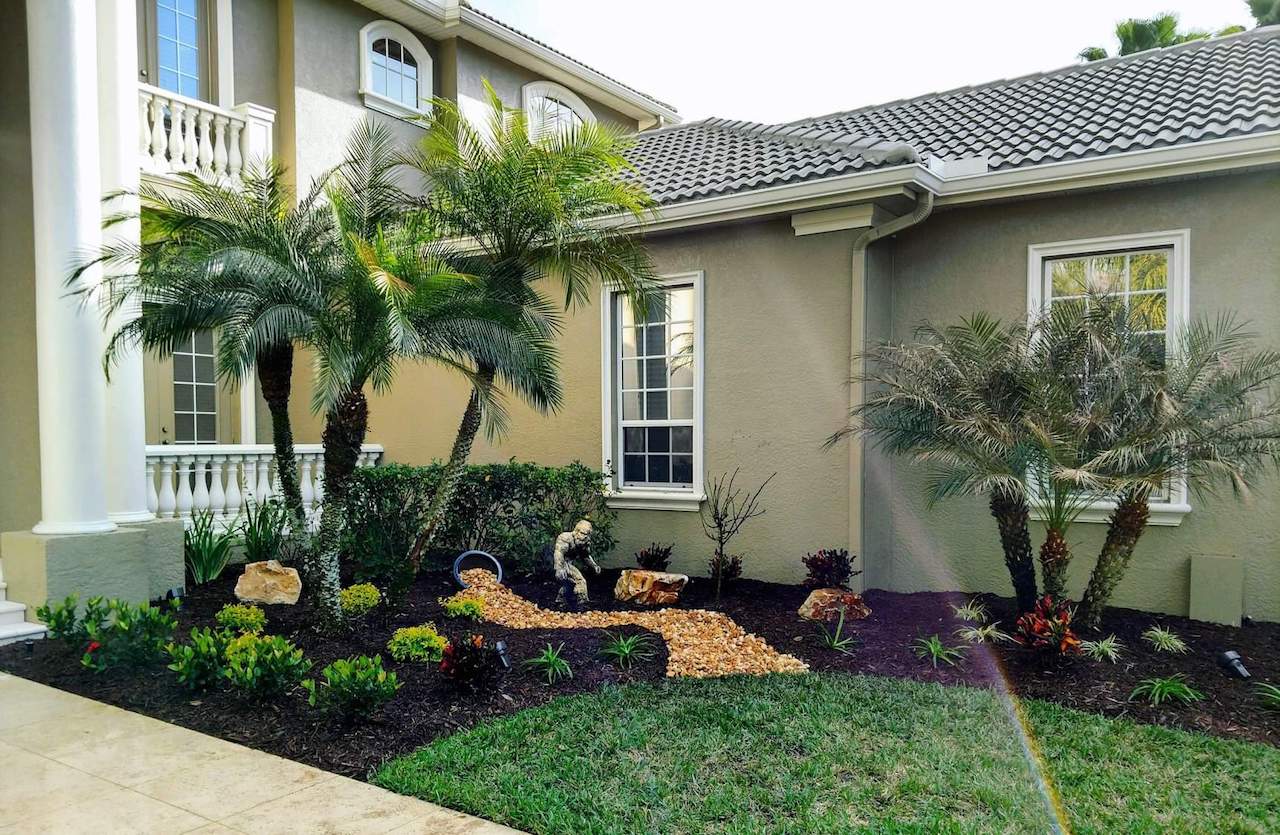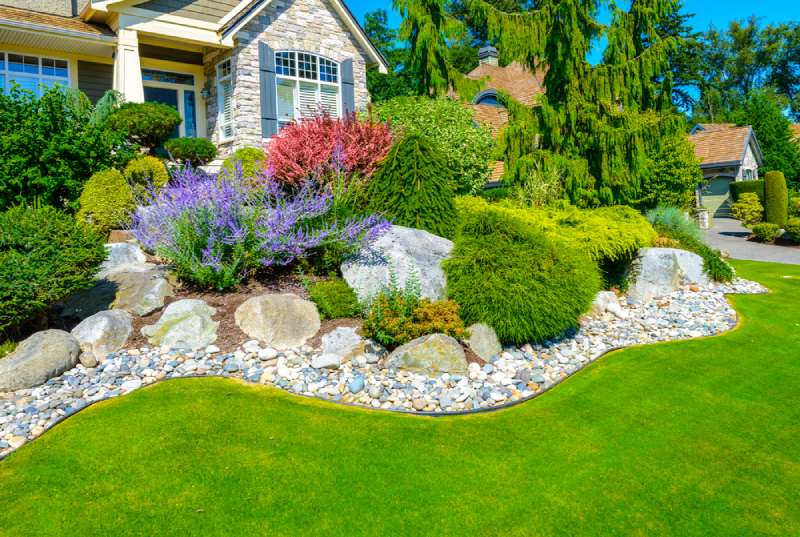Discovering the Best Palm Desert Landscaping Professionals for Your Job
Discovering the Best Palm Desert Landscaping Professionals for Your Job
Blog Article
A Comprehensive Guide to Creating and Implementing Effective Landscape Design Solutions
The art and scientific research of landscaping expand past simple appearances; they entail a thoughtful integration of layout concepts, environmental stewardship, and useful implementation. What approaches can one employ to make certain these landscapes not just prosper however additionally thrive in consistency with their surroundings?

Recognizing Landscape Layout Principles
One might wonder what foundational elements add to effective landscape layout. At its core, effective landscape design depends upon numerous vital concepts that guide the plan and choice of components within an area. These principles consist of unity, percentage, balance, and rhythm, each serving to produce an unified exterior atmosphere.
Unity refers to the cohesive partnership amongst numerous elements, ensuring that they collaborate visually and functionally. Balance can be achieved via unbalanced or symmetrical setups, permitting the landscape to feel secure and inviting. Percentage includes recognizing the scale of aspects in regard to each other and the surrounding setting, promoting visual consistency and comfort.

Analyzing Your Outdoor Area
Before executing the concepts of landscape layout, a comprehensive analysis of your outdoor room is vital. This first examination aids specify the scope of your landscape design task and makes sure that your style aligns with the distinct characteristics of your home. Begin by evaluating the dimensions of your space, taking exact measurements to understand the readily available area for numerous aspects such as outdoor patios, gardens, and paths.
Next, observe the existing functions of your landscape, consisting of topography, dirt quality, and water drainage patterns. These aspects dramatically influence plant option and placement. Furthermore, evaluate the sunlight direct exposure throughout different areas throughout the day, as this will affect the sorts of plants that grow in your yard.
Think about the microclimates created by structures, trees, and other challenges, as they can affect temperature level and moisture degrees. Take note of any existing plants or hardscape elements that you desire to remove or retain. This detailed examination lays the groundwork for a knowledgeable and efficient landscaping remedy, making certain that your layout is not just aesthetically pleasing but additionally useful and sustainable for many years to find.
Lasting Landscaping Strategies
These methods not just advertise ecological equilibrium yet likewise enhance the visual and useful worth of a landscape. Executing reliable watering systems, such as drip watering, decreases water waste and makes sure that plants receive ample wetness (Palm Desert Landscaping).

One more reliable technique is the critical placement of hedges and trees to provide natural windbreaks and color, thus decreasing energy expenses (Palm click for more info Desert Landscaping). Rainfall gardens can be incorporated into the landscape style to handle stormwater overflow efficiently, filtering pollutants before they enter rivers
Selecting the Right Plants
Selecting the right plants for your landscape is critical to accomplishing both aesthetic try here appeal and environmental consistency. The process starts with an understanding of your local environment, soil problems, and the particular microenvironments within your landscape. Analyzing factors such as sunshine direct exposure, dampness degrees, and existing plants will certainly aid you choose plants that grow in your special setup.
Think about integrating indigenous plants, as they are well-adapted to regional problems, need much less maintenance, and support neighborhood wildlife. In addition, picking a diverse selection of varieties can enhance biodiversity while lowering the risk of condition and bug episodes. It is essential to examine the growth routines, blooming periods, and seasonal shades of potential plants to develop a cohesive and dynamic landscape.
Additionally, consider the meant use the room; for example, if the area will certainly experience high foot web traffic, opt for resilient ground covers. By attentively picking plants that straighten with both your aesthetic goals and environmental demands, you can develop a lasting landscape that not just boosts your building yet likewise contributes positively to the bordering environment.

Application and Maintenance Techniques
As soon as the right plants have been selected for your landscape, the focus moves to reliable execution and recurring upkeep methods. Effective installation begins with proper site preparation, that includes dirt testing to figure out nutrient levels and pH, followed by modifying the dirt as needed. Meticulously set up plants according to their development habits and light demands, making sure appropriate spacing to promote healthy development.
Irrigation is an essential element of execution. Develop a watering schedule that thinks about the particular demands of each plant species, adjusting for seasonal check it out modifications. Utilizing drip irrigation systems can improve water effectiveness and minimize overflow.
Maintenance techniques must be implemented to guarantee the long life and vigor of your landscape. Routine jobs consist of weeding, mulching, and pruning to control growth and protect against condition. Fertilizing should be carried out based upon dirt examinations, providing the required nutrients without over-fertilizing.
Monitoring for pests and diseases is vital; early detection can prevent substantial damages. Finally, seasonal adjustments to maintenance regimens, such as preparing and winterizing perennials for springtime development, will make certain that your landscape remains visually attractive and healthy year-round.
Final Thought
In verdict, effective landscaping remedies need an extensive understanding of design concepts, precise evaluation of outside spaces, and the application of sustainable methods. The option of appropriate plant varieties plays a vital duty in enhancing aesthetic allure and eco-friendly durability - Palm Desert Landscaping. Successful implementation and continuous maintenance further guarantee the durability and vigor of landscapes. By incorporating these aspects, landscapes can be changed into gorgeous, practical settings that promote biodiversity and add favorably to area well-being.
One may wonder what fundamental aspects add to reliable landscape design. At its core, effective landscape style pivots on a number of key principles that lead the plan and choice of elements within a space.Choosing the right plants for your landscape is critical to achieving both aesthetic appeal and ecological consistency. It is necessary to evaluate the development practices, growing durations, and seasonal colors of prospective plants to produce a dynamic and cohesive landscape.
As soon as the right plants have actually been chosen for your landscape, the focus changes to effective implementation and recurring maintenance strategies.
Report this page